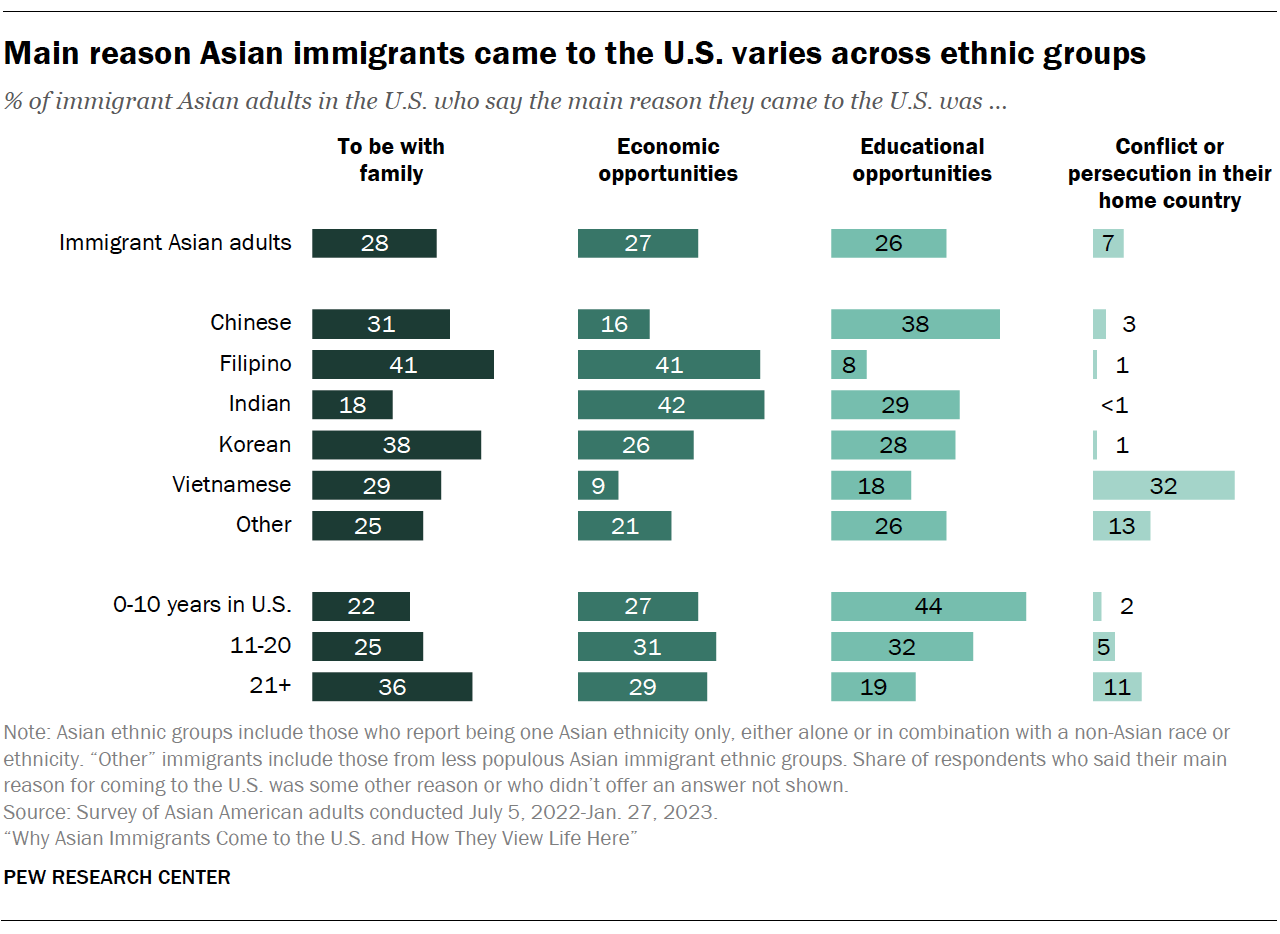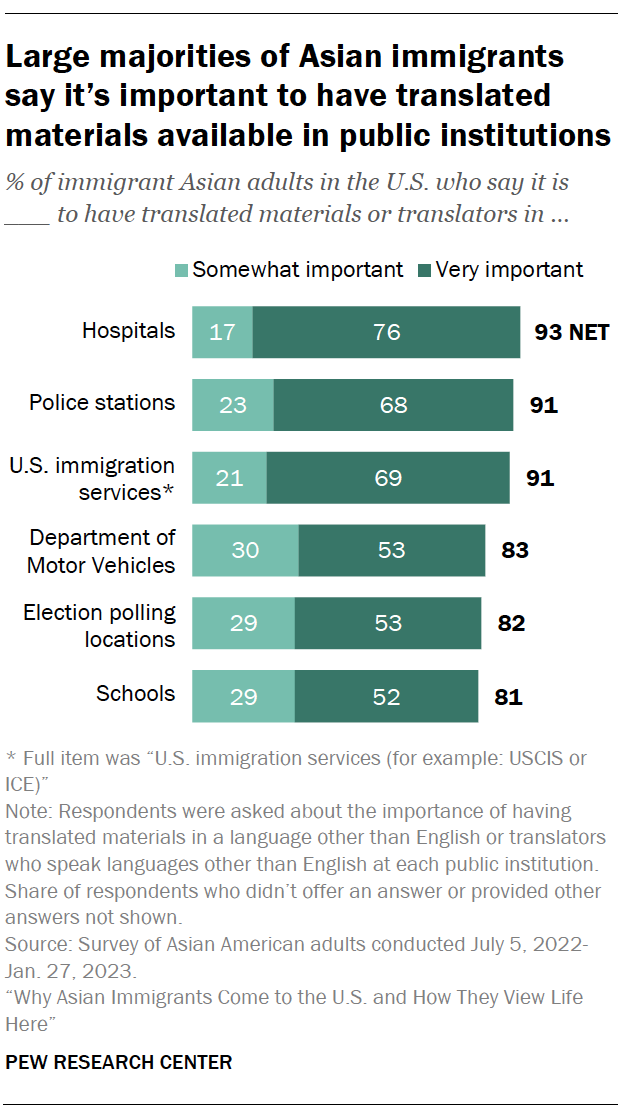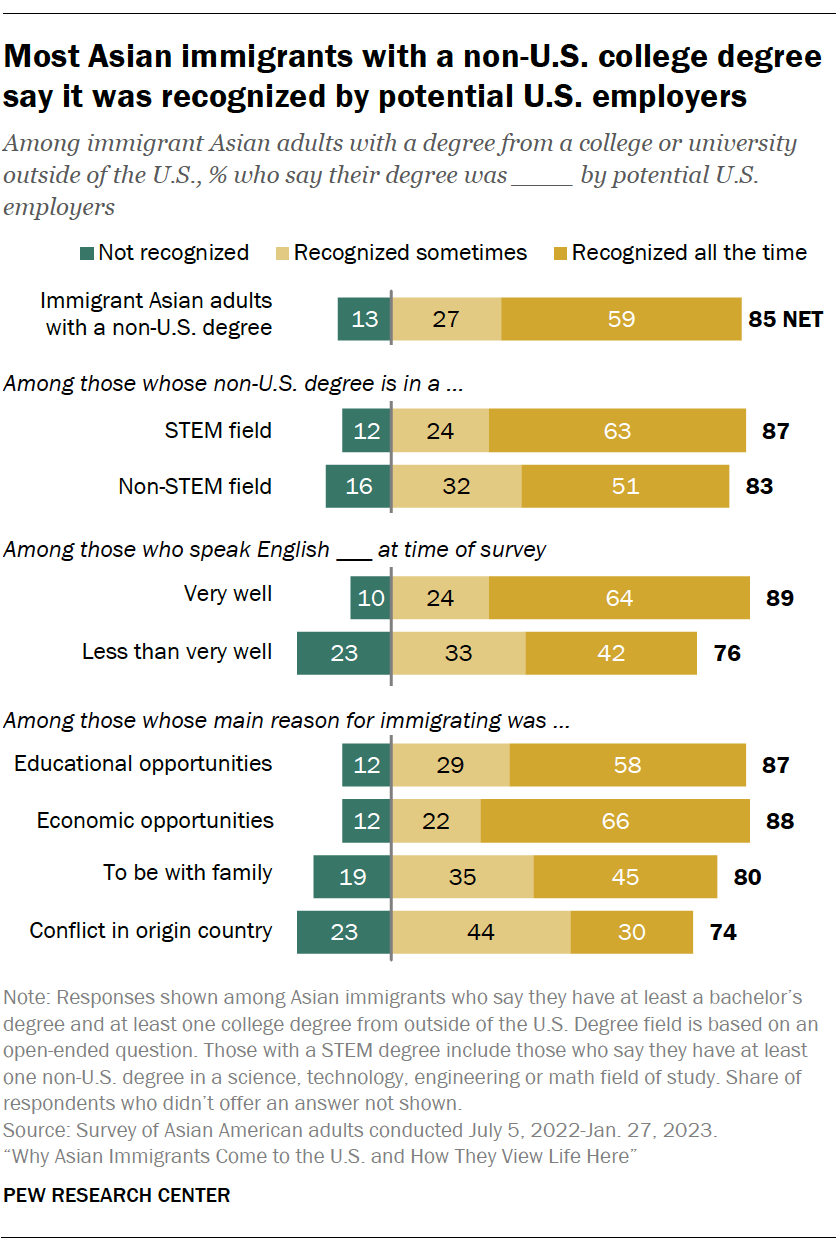Asian immigrants come from many cultures and origins. Their migration stories are also diverse. The Vietnam War and other conflicts in Southeast Asia brought Vietnamese and other Southeast Asian refugees to the United States. More recently, flows of Asian immigrants, particularly highly skilled immigrants from India and China, came to study and work in the U.S.
This chapter explores Asian American immigrants’ backgrounds and their experiences adjusting to life in the U.S.

Some 13 million Asian Americans are immigrants, making up 54% of the Asian American population in 2022, according to a Pew Research Center analysis of the Census Bureau’s American Community Survey. The five largest Asian immigrant groups – Indian, Chinese, Filipino, Vietnamese and Korean Americans – make up about 80% of the Asian American immigrant adult population. Additionally, 14% of Asian immigrants are of another single Asian ethnicity and 6% identify with two or more Asian ethnicities.
Asian American immigrants’ experiences in the United States are impacted by their diverse demographic backgrounds.
- Years in the U.S.: About half (51%) of Asian immigrant adults have lived in the country more than 20 years. Some 22% have been in the country for 11 to 20 years, and another 27% have lived in the U.S. for a decade or less.
- Education: Among those ages 25 and older, 57% have a bachelor’s degree or higher, while 28% have a high school diploma or less.
- Income: 52% of Asian immigrant adults live in families with a yearly income of $100,000 or more, while 14% are in families with yearly incomes of less than $30,000.
Why do Asian immigrants come to the U.S.?
Asian immigrants have different motivations for coming to the U.S. According to the Center survey, 28% say they immigrated to the U.S. to be with family, 27% immigrated for economic opportunities, 26% immigrated for educational opportunities, and 7% immigrated due to conflict or persecution in their origin country. Some 4% cited other reasons for coming to the U.S.3
Asian immigrants’ main reason for coming to the U.S. differs significantly by ethnic groups and by how long ago they arrived in the country.

By ethnicity
- Among Chinese immigrants, 38% say they came for educational opportunities while 31% immigrated to be with family.
- Among Filipino immigrants, 41% immigrated for economic opportunities and another 41% say they came to be with family.
- Among Indian immigrants, the most common reasons given were economic opportunities (42%) and educational opportunities (29%).
- Among Korean immigrants, 38% immigrated to be with family, while 28% and 26% say they came for educational or economic opportunities respectively.
- Among Vietnamese immigrants, 32% say they came mainly to avoid conflict or persecution in their origin countries, and 29% say they immigrated to be with family.
- Among immigrants of less populous ethnic groups, about a quarter each say they came for educational opportunities (26%) or to be with family (25%). Some 21% say they came for economic opportunities, and 13% say they came due to conflict or persecution in origin countries.
By years in the U.S.
Nearly half of those who have been in the country 10 years or less say they came to the U.S. for educational opportunities (44%). Smaller shares of those who have been in the U.S. for 11 to 20 years (32%) and those living in the country more than 20 years (19%) say the same.
Those who have been living in the country more than 20 years are most likely to say their main reason for coming was to be with family (36%). Smaller shares of those who have been in the U.S. for 11 to 20 years (25%) or 10 years or less (22%) say the same.
Where do Asian immigrants find support when they arrive in the U.S.?
Many immigrants face financial challenges when they first arrive in the U.S. due to various factors, such as language barriers and a lack of credit history in the country.
In the first six months of living in the U.S., a majority of Asian immigrants (58%) say they received financial assistance in some form. This includes:
- 52% who say they received financial assistance from family or friends.
- 15% who received assistance from federal, state or local governments.
- 10% who received assistance from religious organizations, such as churches and temples.
- 5% who received assistance from Asian community organizations.
- 10% who say they received assistance from some other group or person.
Still, about a third of Asian immigrants (35%) say they did not receive financial assistance during their first six months living in the U.S. from any of the sources asked about in the survey.

By main reason for immigrating
About two-thirds of immigrants who came to the U.S. due to conflict or persecution in origin countries (64%) say they received assistance from the government during their first six months in the U.S. By comparison, only about one-in-ten immigrants who came for other reasons say the same.
Immigrants who came to the U.S. for economic opportunities are the least likely to say they received help from any source. About half say this (50%), compared with 85% among those who came to escape conflict, 70% who came for educational opportunities and 60% of those who came to be with family.
By ethnicity
Vietnamese immigrants and immigrants of less populous ethnic groups are more likely than Chinese, Filipino, Indian and Korean immigrants to say they received financial assistance from the government, religious organizations and Asian community organizations within six months of immigrating. Notably, these are also the groups most likely to cite escaping conflict as one of the main reasons for immigrating to the U.S.
- 48% of Vietnamese immigrants say they received financial assistance from governments. A quarter of immigrants from less populous immigrant ethnic groups say the same.
- 28% of Vietnamese immigrants, 19% of immigrants from less populous ethnic groups and 9% of Korean immigrants received assistance from religious organizations when they arrived in the country, compared with fewer than 5% among other ethnic groups.
- 11% of Vietnamese immigrants and immigrants of less populous origin groups each say they received financial assistance from Asian community organizations. Fewer than 5% in other ethnic groups say the same.
The share saying they did not receive assistance from any of the sources varies across ethnic groups, ranging from a high of 48% among Indian immigrants and low of 16% among Vietnamese immigrants.
Do Asian immigrants think it’s important to speak English to succeed in the U.S.?
Newly arrived immigrants face many challenges, including language and cultural obstacles. In focus groups of Asian Americans conducted by Pew Research Center in 2021, some immigrant participants discussed difficulties navigating daily life, school and the workplace due to language barriers. And some Asian immigrants report experiences with discrimination tied to people’s assumptions about their English-speaking abilities.
The survey asked about Asian immigrants’ views of and experiences with the English language. It found that 64% say they could read or speak English before moving to the U.S. And nearly all Asian immigrants (91%) say speaking English is necessary to get ahead in the U.S.
Asian immigrants’ English language skills

In 2022, 59% of Asian immigrants ages 5 and older spoke English proficiently, meaning they speak only English at home or say they can speak English very well. This is up from 51% who did so in 2000, according to a Center analysis of Census Bureau data.
According to the Center’s survey, 86% of immigrant Asian adults say they can speak English very well or pretty well. And many Asian immigrants report arriving in the country with English skills: 64% of Asian immigrants say they could speak or read English before immigrating to the U.S.

Asian immigrants’ English abilities vary across some demographic subgroups:
- Main reason for immigrating: Immigrants who came to the U.S. mainly for educational or economic reasons are more likely to say they could speak or read English before moving to the U.S., compared with those who immigrated to be with family or to escape conflict.
- Ethnicity: Filipino and Indian immigrants are the only ethnic groups where a large majority could speak or read English before immigration. Higher shares can also speak English well at the time of the survey.
- Years in the U.S.: While immigrants who arrived more than 10 years ago were more proficient in English at the time of the survey, those who arrived in the last 10 years are more likely to say they were able to speak or read English before immigrating to the U.S.

Asian immigrants’ views of the English language in the U.S.
When it comes to the importance of speaking English, nearly all Asian immigrants say speaking it is necessary to get ahead in the U.S. (91%).
At the same time, vast majorities say it is at least somewhat important to have translated materials other than English available in public institutions such as hospitals, police stations, immigration service centers, departments of motor vehicles, election polling locations and schools.
For Asian immigrants, are college degrees earned outside the U.S. recognized by U.S. employers?
Another challenge some Asian immigrants face is whether the qualifications they earned outside the U.S. will be recognized by U.S. employers.
According to the Center survey, a majority of Asian immigrant adults have a bachelor’s degree or higher (54%), and 33% of all Asian immigrant adults earned a college degree outside of the U.S. Among those with at least a bachelor’s degree and who received a non-U.S. college degree, 61% said that degree is in the fields of science, technology, engineering or mathematics (STEM).4

Among those with a non-U.S. degree and at least a bachelor’s, 85% say their non-U.S. degree was recognized by potential U.S. employers, either sometimes (27%) or all the time (59%). About one-in-ten say their degree was not recognized at all (13%).
Whether Asian immigrants’ non-U.S. degrees are recognized by potential employers varies somewhat by their field of study, their English ability before immigration and today, and their main reason for immigrating.
Among Asian immigrants with at least a bachelor’s and a degree from a university or college outside of the U.S.:
By main reason for immigrating
- A majority who migrated mainly for economic (66%) and educational opportunities (58%) say their non-U.S. degree is recognized by U.S. employers all the time, compared with fewer than half among those who came for other reasons.
- About a quarter of those who initially immigrated due to conflict in their origin country (23%) say their non-U.S. degree is never recognized by potential employers.
By field of study
- 63% of Asian immigrants with a non-U.S. degree in a STEM field say it is recognized by U.S. employers all the time.
- 51% of those who have non-U.S. degrees in non-STEM fields say the same.
By English ability before immigrating to the U.S.
- 60% of Asian immigrants who could speak or read English before moving to the U.S. say their degree is always recognized, compared with 27% of immigrants who could not speak or read English before immigration.
- 41% who could not speak or read English before migration say their non-U.S. degree is never recognized, compared with 13% of immigrants who could speak or read English before immigrating to the U.S.
By English proficiency today
- 64% of Asian immigrants with a non-U.S. degree who speak English very well say their degree is always recognized; 42% of those with a non-U.S. degree who speak English less than very well say the same.
- 23% of those who are less than proficient in English say their non-U.S. degree is never recognized, compared with 10% of English proficient immigrants with a non-U.S. degree.




